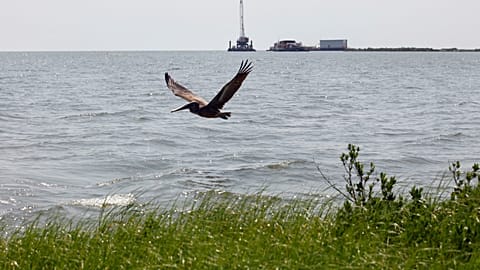Here's how fossil fuel companies get their hands on ‘climate-friendly’ funds.
Millions of euros in ‘climate-friendly’ investments have been awarded to major carbon emitters, a new investigation reveals.
Fossil fuel giants BP, Chevron, Eni, Exxon, Repsol, Shell and Total Energies were among the benefactors, according to Voxeurop.
The investigation scrutinised green funds promoted by Eurizon Capital SGR, an asset management company controlled by Intesa San Paolo, Italy’s largest bank.
Eurizon is one of several financial players across Europe that use deceptive phrasing and loopholes in the EU regulatory framework to sell supposedly ‘green’ financial products that actually fund big polluters.
‘Green’ investments are not always sustainable
Europe is a worldwide leader in the market for so-called ‘green’ investments. As Voxeurop’s investigation reveals, however, those investments are often neither sustainable nor responsible.
By exploiting ambiguous regulations and obscure terminology, some of them are actually financing fossil fuel companies.
Voxeurop analysed four so-called ‘sustainable’ funds offered by Eurizon. The asset-management company is one of many financial institutions offering ‘green’ products in Europe, managing client assets worth €381 billion.
In 2022, Eurizon bought shares in the seven fossil fuel companies for a value of more than €208 million and placed them within portfolios it called ‘sustainable and responsible investments’.
According to data from financial market analyst Refinitiv, as of April 2023, a total of $8.2 billion (€7.6b) in funds classified as green under EU rules were awarded to the fossil energy companies by Eurizon.
Eurizon-backed fossil fuel majors are involved in the 195 mega oil and gas projects that would alone be capable of exhausting the remaining 1.5°C carbon budget allowed by the Paris Climate Agreement.
How do fossil fuel companies get green funding?
Repsol and other fossil fuel companies “have an interest in getting into ‘green’ funds because they will receive more funding that way,” explains Fabio Moliterni, a specialist at the ethical finance company Etica SGR.
By attracting investors through ambiguous language, these falsely sustainable funds have managed to outperform their market. They have guaranteed high returns by tracking indices that are completely devoid of sustainability targets.
“The European Commission’s rules leave a margin of discretion to investors in determining their sustainability targets,” says Moliterni. “This makes it easier for the market to adapt flexibly to changes in the regulatory landscape of asset management, and thus to enable product differentiation.
“But it does not seem to preclude greenwashing. In fact, many funds are still able to pursue strategies that are not aligned with the Commission’s sustainability objectives and instead prioritise returns, with little or no attention to environmental and social impact.”
Alessandro Messina, an expert in impact finance and sustainability for the independent sustainable development company Avanzi, adds that “fund managers try to comply with EU regulations as much as possible, but if they have a profitable product on the market they do not try too hard to force the rules.”
Eurizon's pre-contractual prospectus even presented the funds in question as “sustainable and responsible investments”. This was despite the fact that they do not comply with the criteria laid down in the EU Regulatory Framework.
How is sustainable finance regulated?
The European Sustainability Reporting Regulation for the Financial Services Sector, which came into force in 2021, imposes transparency criteria that financial advisors must meet in pre-contractual documents and on green investments.
Investors should be steered towards investments that can be classified by the manager into two shades of ‘green’ (corresponding in the regulation to articles 8 and 9) or as ‘grey’, i.e. without sustainable claims (Article 6).
The ‘light green’ products fulfil the criteria listed in Article 8 and must promote “environmental and/or social characteristics”. But there is no clear definition of these characteristics.
This loophole allows managers to classify their funds as light green according to their own principles or according to rating agencies’ assessments - even if the funds contain environmentally unsound companies.
The European Securities and Markets Authority (ESMA) merely says that light green funds have a lower ambition with regard to sustainability than ‘dark green’ ones. The latter must have a 100 per cent sustainable investment as their objective, meaning they must not cause significant damage to the environment or must promote the reduction of carbon emissions.
Light vs dark green funds
The difference between the two terms - products that “promote environmental features” (light green) and “sustainable products” (dark green) - may seem marginal to an inexperienced investor. But the distinction is clear from a regulatory point of view.
Dark green funds must meet much stricter criteria. That is why they are more attractive to conscientious investors, but less so to fund managers who would incur greater burdens in complying with the regulations.
The EU regulation is based entirely on transparency. Managers can therefore choose how to classify funds - be it grey, light green or dark green.
ESMA's technical standards, adopted on 1 January 2023, increased the transparency burden for ‘dark green’ products to such a point as to prompt a significant migration to the ‘light green’ classification instead.
These reclassified funds reached a value of €175 billion in 2023, according to a study by the financial advisory and analysis firm Morningstar.
What are the criteria for dark green funds?
For all dark green sustainable investments, fund managers must provide metrics, data, methodologies and detailed information on 14 indicators prescribed by EU regulations, called ‘Principal Adverse Impacts’ (PAI).
These indicators include the greenhouse gas emissions of portfolio companies (direct, indirect and total) and the presence of fossil fuel companies in the investment.
Nonetheless, sustainable fund managers can still get away with having big polluters in their portfolios.
Firstly, thanks to the flexibility offered by Article 8, fund managers can independently define the criteria by which they consider that a fund promotes “environmental and/or social characteristics” (light green).
Secondly, by exploiting the ambiguities in the meaning of words for the unwary investor, many managers choose to market funds that do not meet the Article 9 criteria as “sustainable and responsible”.
Eurizon labelled fossil fuel funds as ‘light green’
In its management report, Eurizon defines its funds as ‘light green’ despite the fact that it invests in fossil-extractive companies.
The sustainability disclosure section - where the social and environmental characteristics of the product should be described - is left empty, even though that information is required by ESMA standards.
For over three years, Eurizon labelled certain funds as dark green, i.e. as entirely sustainable and responsible, in the pre-contractual documents made available to investors. The company only corrected the language after Voxeurop contacted it for this investigation.
Not only does Eurizon admit that it takes into consideration only six of the 14 indicators provided by the EU for the assessment of sustainable investments, but in its periodic disclosure on the promotion of environmental, social and corporate governance (ESG), it merely mentioned them, rather than going into the details of the information required by the EU regulations.
Compliance and enforcement are lacking for green funds
The EU regulation, in fact, provides a detailed table in which managers must include metrics, periods considered for the calculation, an explanation of the methodology, and forecasts for subsequent periods.
These criteria are supposed to transparently identify and quantify any negative environmental and social impacts of the proposed investment.
Such information is indispensable for investors to assess whether the product is sufficiently sustainable before putting their money into it.
“The manager can declare whatever they want, but then they have to document what the adverse impacts are according to the metrics,” comments Franco Moliterni of Etica SGR.
Yet Eurizon has limited itself to providing the documents mentioned in the regulations but without including the data.
“This seems to me to be a compliance and enforcement issue,” says Messina. “You cannot qualify an investment as sustainable if it is Article 8. You can qualify it as ‘Attention to Sustainability Elements’: that's the difference the regulations make.
“Evidently there is someone who either has been too clever or doesn't really know what they are talking about.”
Questioned by Voxeurop in May 2023 on this inconsistency, Eurizon said that the sustainable investment qualification “will be removed at the first useful opportunity to update the offering documentation, already planned for next July.”
On 4 August 2023, Eurizon updated its key information document, removing the words “sustainable and responsible fund”, as promised. The update came three years and six months after the green finance regulation came into force.
The investigation by Voxeurop was conducted with the support of Journalismfund Europe.


















